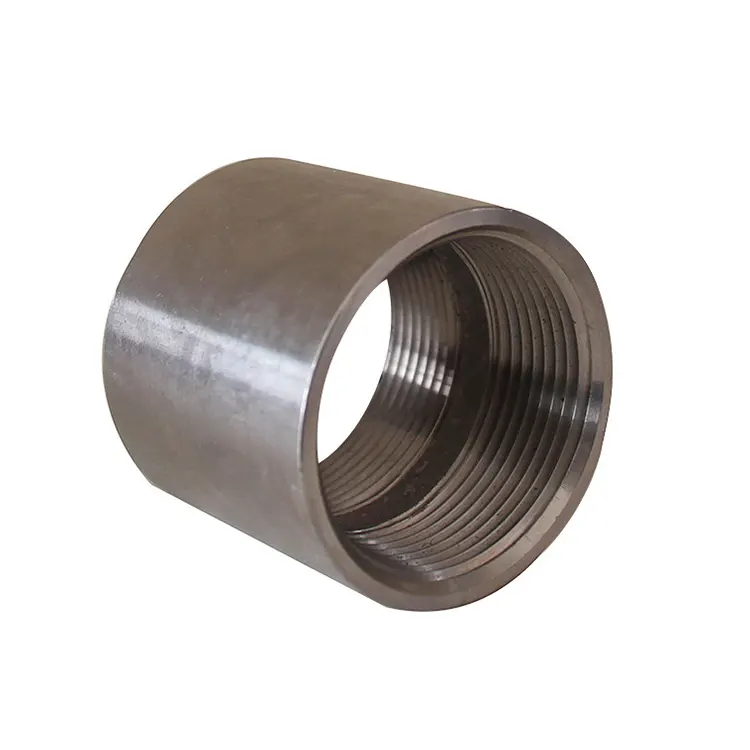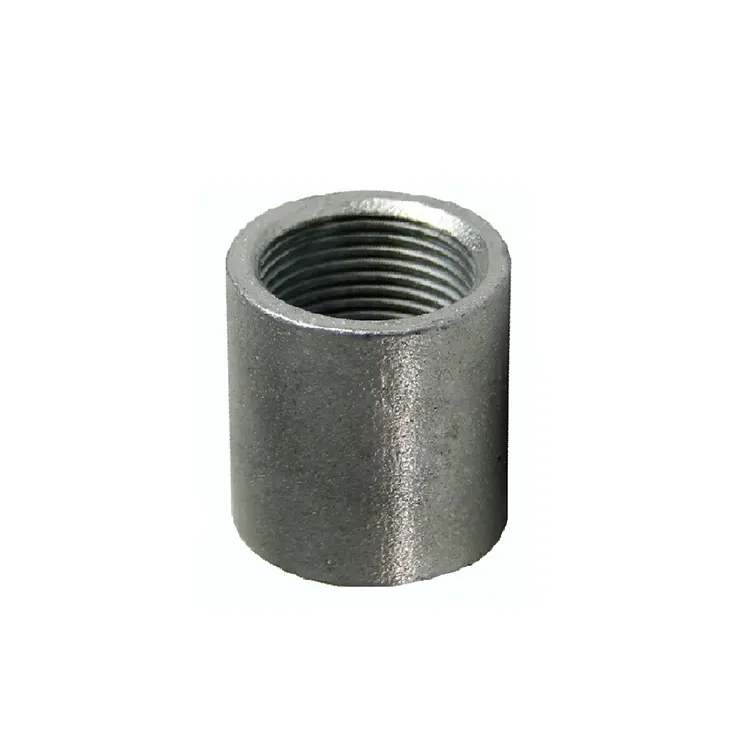Product Description
Detailed Photos
Product Description
Features:
Material :ASTM A865 / BS EN 15711
Dimensions :ASTM A865 / BS EN 15711
Threads :ASME B1.20.1/NPSC / NPT / BSPT/ ISO 7/1
Type: For STD pipe, XS pipe, XXS pipe
Surface: Black / galvanized
Schedule :Standard/Extra-Strong/Medium/Heavy
Half couplings are available in black, galvanized and stainless steel. Full Merchant couplings are used when stronger coupling fittings are required. For example, you can use an Full Merchant coupling in the downpipe of a well because it can hold the weight of the pipes, water and submersible pump. If a stronger joint is required, drop tube joints specifically designed for these applications are available. Black all Full Merchant are also available for applications requiring welding.
Note that Full Merchant couplings should never be used as fittings in plumbing systems where a watertight seal is critical. However, tapered Full Merchant are available for such applications.
Half merchant couplings are half the size and are used to provide threaded outlets on the flat face of metal tanks. The tank is drilled with holes/ports and the coupling halves are welded to the tank centered on the ports. One half of the coupling goes all the way through the threads, but is squared off at 1 end to aid in welding to the tank.
Half merchant couplings are designed for welding and are therefore only available in black finish. This means they are not available with a galvanized finish, as welding galvanized fittings produces fumes which are harmful to health.
Produce process
Product Parameters
Quality control
Fluid Tech Group is a professional manufacturer of pipe fittings in China. All products are designed, manufactured and tested in strict accordance with DIN, BS, ISO, ANSI, API and JIS standards.
The main products include steel pipe joints, steel sockets and sockets: black or galvanized, seamless or welded; stainless steel pipe fittings, King Nipple: unions, elbows, reducers, bushings, couplings, caps, nuts, soft Pipe joints, etc.; butt welding pipe fittings. We also offer pipe cutting, bending, threading and end finishing, exclusively to meet custom services. At present, our products are exported to North America, Europe, Central and South America, Southeast Asia, Middle East and Africa markets, and the products are very popular.
Application and Case
Products are used in fire protection system, water system, CHINAMFG system, plumbing, gas system, irrigation system, etc.These products are used in many projects , such as ZheJiang Airport, ZheJiang World Trade Center, Canton Tower and other famous landmark projects
Packaging & Shipping
FAQ
1. What is the minimum quantity of the order?
Answer: The purchase volume of mixed products is 4 tons
2. How long is the delivery time of the order?
Answer: The delivery time for general orders is about 30 days. If the order is urgent and we have stock, around 7 days.
3. What payment methods do you accept?
Answer: We accept payment terms such as TT, L/C, DP, Western Union, Paypal, etc.
4. Where is your departure port of shipment? Is it possible to deliver to the designated warehouse?
Answer: The port of departure of our goods is generally ZheJiang Port or HangZhou Port. We can transport the goods to designated warehouses, such as HangZhou, HangZhou, etc.
5. What certificates do your products have?
Answer: Our products have FM/UL certificates, and we cooperate with third-party quality inspection certification before the factory, such as SGS,TUV
6.What are the series of your products?
Answer: Our products are divided into heavy series, medium series and light series according to different markets and standards. In order to buy more competitive products for you, please communicate your purchasing needs with the salesperson.
7. Do product packaging cartons and labels support customization?
Answer: Packaging cartons and labels can be customized according to customer requirements.
8.Does the purchased product support customization?
Answer: The product supports customization, but there are purchase quantity requirements and mold costs. For details, please consult the salesperson.
9.What are the packaging methods of the product?
Answer: The packaging of the product includes carton packaging, pallet packaging, wooden box packaging, and woven bag packaging.
/* January 22, 2571 19:08:37 */!function(){function s(e,r){var a,o={};try{e&&e.split(“,”).forEach(function(e,t){e&&(a=e.match(/(.*?):(.*)$/))&&1
How do you Properly Install and Secure a Half Coupling to Ensure a Leak-Free Connection?
Properly installing and securing a half coupling is essential to ensure a leak-free and reliable connection in piping and plumbing systems. Follow these steps to achieve a secure joint:
- Cut and Prepare the Pipe: Start by cutting the larger pipe to the desired length, ensuring a clean and even edge. Use a deburring tool or file to remove any sharp edges or burrs that could interfere with the coupling’s sealing surface.
- Check Threads and Fit: For threaded half couplings, inspect the internal threads of the coupling and the external threads of the pipe. Make sure they are clean and free from debris or damage. Ensure that the threads match and fit properly, as any misalignment can lead to leaks.
- Apply Thread Sealant: Before attaching the half coupling, apply a suitable thread sealant, such as Teflon tape or pipe dope, to the male threads of the pipe. The sealant helps prevent leaks by filling any gaps or imperfections in the threads.
- Attach the Half Coupling: Thread the half coupling onto the pipe’s male threads carefully. Use a wrench to ensure a snug fit, but avoid over-tightening, as it may damage the threads or cause stress on the joint.
- For Socket Weld or Butt Weld Couplings: For socket weld half couplings, insert the smaller pipe into the coupling’s socket and align it properly. For butt weld half couplings, weld the coupling to the larger pipe’s end with proper welding techniques and safety measures. Follow industry standards for welding procedures and ensure a smooth and consistent weld for a leak-free joint.
- Check for Leaks: After installation, perform a leak test to ensure the joint is secure. Apply a pressure test or use a suitable leak-detection method to verify the connection’s integrity. If any leaks are detected, disassemble the joint, inspect for issues, and reassemble following the proper steps.
- Consider Thermal Expansion: In applications with temperature variations, consider the thermal expansion and contraction of the pipes. Provide sufficient flexibility in the system to accommodate these changes and prevent stress on the joints, which could lead to leaks over time.
- Follow Manufacturer’s Instructions: Always follow the manufacturer’s instructions and recommendations for the specific type and material of the half coupling being used. Different couplings may have unique installation requirements and torque specifications.
Proper installation and securing of a half coupling are crucial for maintaining the integrity of the piping or plumbing system and ensuring a leak-free connection. Following these steps and adhering to industry standards will help achieve a reliable and durable joint.
How do you Select the Right Half Coupling Material Based on the Fluid or Gas being Conveyed?
Choosing the appropriate material for half couplings is essential to ensure their compatibility with the fluid or gas being conveyed. The selection process involves considering several factors related to the nature of the conveyed substance and the specific operating conditions. Here’s a step-by-step guide on how to select the right half coupling material:
- Identify the Conveyed Fluid or Gas: Determine the type of fluid or gas that will flow through the piping system. Different materials may be required depending on whether the conveyed substance is water, oil, gas, chemicals, steam, or any other medium.
- Consider the Chemical Compatibility: Evaluate the chemical properties of the conveyed substance. Some fluids or gases can be corrosive or reactive with certain materials. Look for half coupling materials that are chemically resistant to the specific medium to prevent degradation or premature failure.
- Assess the Temperature and Pressure: Take into account the operating temperature and pressure of the system. High-temperature fluids or gases may require materials with excellent heat resistance, while high-pressure applications demand strong and durable coupling materials that can withstand the stress.
- Check for Abrasion or Erosion: In systems where the conveyed substance contains solid particles or abrasive materials, consider half coupling materials with good wear resistance to prevent premature wear and damage to the coupling surface.
- Verify Material Standards: Ensure that the selected half coupling material complies with relevant industry standards such as ASTM, ASME, API, or ISO. These standards define the material’s properties and performance criteria, providing a reliable benchmark for quality and suitability.
- Consider Environmental Conditions: Evaluate the environmental factors that can affect the coupling’s performance, such as humidity, UV exposure, or exposure to harsh chemicals. Choose materials with appropriate coatings or properties to withstand the specific environmental conditions.
- Factor in Cost and Availability: Balancing performance requirements with cost considerations is essential. Select a half coupling material that meets the necessary performance criteria while fitting within the project’s budget. Additionally, ensure that the chosen material is readily available for procurement.
Common materials used for half couplings include carbon steel, stainless steel, alloy steel, brass, bronze, and various plastics such as PVC, CPVC, and PTFE. Each material has its advantages and limitations, making the selection process critical for a successful and reliable piping system.
By carefully considering the conveyed fluid or gas, chemical compatibility, temperature, pressure, abrasion resistance, and other relevant factors, you can make an informed decision and select the right half coupling material that will ensure a safe and efficient operation of the piping system.
What are the Standard Sizes and Dimensions Available for Half Couplings?
Half couplings, as pipe fittings used in piping and plumbing systems, are available in various standard sizes and dimensions to accommodate different pipe sizes and applications. The sizes and dimensions of half couplings depend on the pipe’s nominal diameter and the specifications set by industry standards organizations. Some common standard sizes and dimensions for half couplings are as follows:
- Thread Sizes: Half couplings come with different thread sizes to match the corresponding pipe threads. Common thread sizes for half couplings include 1/8″, 1/4″, 3/8″, 1/2″, 3/4″, 1″, 1-1/4″, 1-1/2″, 2″, 2-1/2″, 3″, 4″, 5″, 6″, and larger.
- Length: The length of a half coupling refers to the distance from one end to the other. It is typically a few inches, depending on the pipe size and application requirements. Lengths for half couplings can range from around 1 inch to 12 inches or more.
- Outer Diameter (OD): The outer diameter of a half coupling refers to the measurement across the widest point of the coupling’s external surface. It corresponds to the pipe’s outer diameter it is intended to connect to. Common OD sizes for half couplings include 1.05″, 1.32″, 1.66″, 1.90″, 2.38″, 2.88″, 3.50″, 4.50″, 5.56″, 6.63″, 8.63″, and others.
- Materials: Half couplings are available in various materials, as mentioned in the previous answer. The material selection depends on factors such as the type of fluid being transported, the temperature, the pressure, and the corrosion resistance requirements.
It is essential to refer to industry standards, such as ANSI (American National Standards Institute), ASME (American Society of Mechanical Engineers), or ASTM (American Society for Testing and Materials), to ensure that the half couplings meet the specific dimensional and material requirements of the application.
When selecting a half coupling, it is crucial to consider the following factors:
- Pipe Size Compatibility: Ensure that the half coupling’s thread size matches the pipe’s thread size to create a secure and leak-proof connection.
- Application Requirements: Consider the operating conditions, including pressure, temperature, and the nature of the fluid being transported, to choose the appropriate material and dimensions for the half coupling.
- Standards Compliance: Select half couplings that meet industry standards to ensure safety and compatibility with other components in the system.
In summary, half couplings are available in various standard sizes and dimensions, with different thread sizes and materials to accommodate diverse pipe sizes and applications. Proper selection based on the specific requirements of the piping or plumbing system is essential for ensuring a reliable and efficient connection between pipes.
editor by CX 2024-05-02




